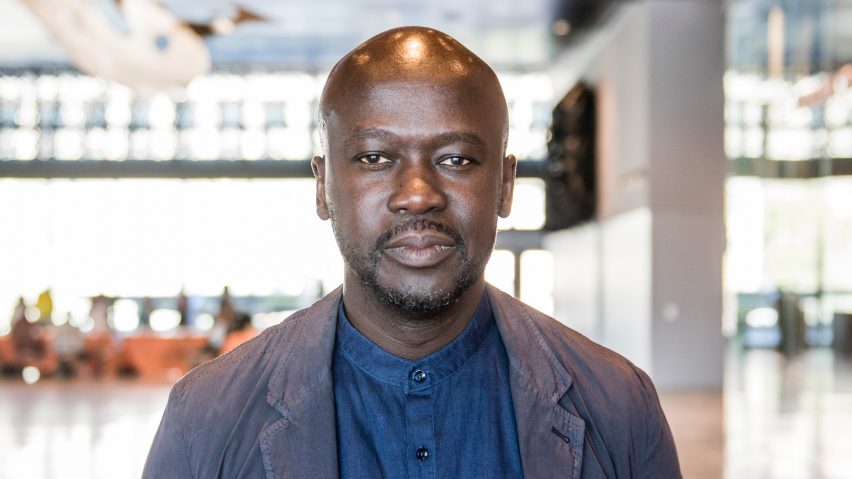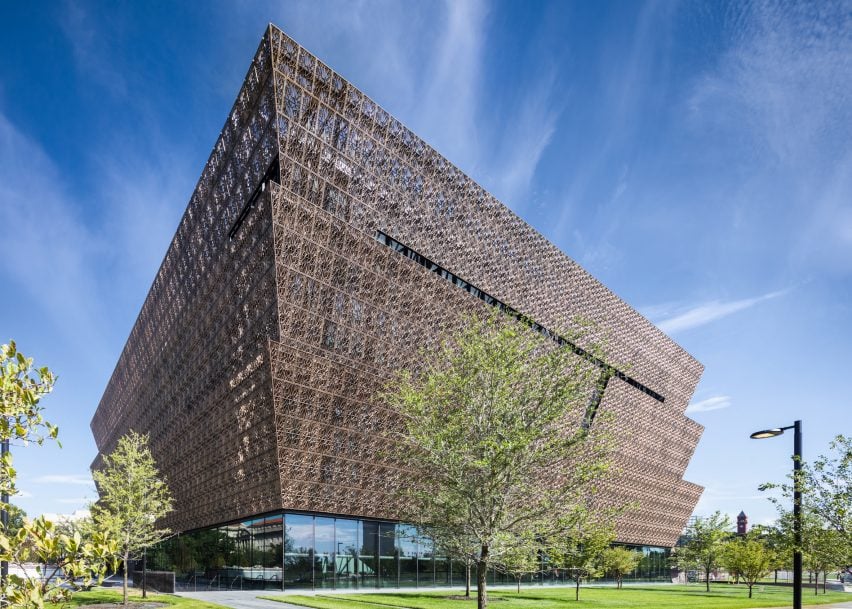
David Adjaye "embarrassed as a male" that women still need to fight for gender equality
The architecture and design industry still doesn't provide the same opportunities for both sexes said architect David Adjaye, on the day that hundreds of thousands of women worldwide marched for equal rights.
Asked whether his sector was at the forefront of gender equality, the recently knighted British architect replied: "I don't think we're leading it at all."
He was speaking to Dezeen during the Interior Design Show in Toronto, one of many cities internationally where huge demonstrations – spurred by the inauguration of US president Donald Trump the day before – took place on Saturday to highlight women's rights.
"I find it exhausting that women are still fighting for gender parity," said Adjaye. "I find it embarrassing to be really honest."
"We're in the 21st century," he continued. "This is such an old story, we should be way past this. I'm embarrassed, as a male."
The architect also said that his recently completed Smithsonian National Museum of African American History and Culture, which was initiated eight years ago, probably wouldn't be built in today's political climate.
"It was really a very politically contested project," said Adjaye said. "You realise how delicate politics and the birth of institutions are, under the providence and convergence of political times."

His remarks follow comments made last month by architect Peter Eisenman, who believes his memorial to the murdered Jews of Europe in Berlin also wouldn't be built today.
Adjaye, 50, was recently awarded a knighthood for his work on the NMAAC, as well as his involvement in improving communities around the world. He said that the award came as a surprise.
"I was totally taken aback," he said. "I just felt incredibly shocked and humbled. It really took the air out of the room for me and my family."
"The knighthood has helped me to have more confidence that I should do what I do, and do more of it."
The architect – who ranked 41st on Dezeen Hot List – said he is currently working on a variety of projects in the USA, including his arts centre in Harlem and a tower in Downtown Manhattan.
These follow his Sugar Hill housing project, also in Harlem, and two libraries in DC that have completed since the London-based firm set up a satellite office in New York 10 years ago.
Read the transcript of our interview with David Adjaye below:
Dan Howarth: Congratulations on your knighthood!
David Adjaye: It was quite a shock.
Dan Howarth: How does it feel?
David Adjaye: I was totally taken aback. I just felt incredibly shocked and humbled. It really took the air out of the room for me and my family.
I had been relentless working on ideas that I just believed in, and I became a workaholic in my family. My mother was like, what is this thing that you're trying to
Hearing about the knighthood made them feel like, this guy's been working on something. He wasn't completely out of his mind. It feels really wonderful that people have noticed that.
I committed to something that I strongly believed in, and getting the knighthood has helped me to have more confidence that I should do what I do, and do more of it.
You realise how delicate politics and the birth of institutions are, under the providence and convergence of political times
Dan Howarth: Did they explain to you in detail about what it was exactly that you were awarded for?
David Adjaye: Absolutely, there was a full report.
Dan Howarth: What were the key points in that?
David Adjaye: There's a kind of British agenda, of a young British architect working in the world, promoting change and dealing with communities, and transforming and empowering communities around the world.
There's that background. And really the highlight being the Smithsonian. Working on that for eight years and delivering a significant cultural institution for America, at this time, in this world. That is unprecedented.
So the award is for the body of work building up but really, the prize is having delivered the Smithsonian project. It's pretty powerful.
Dan Howarth: We're speaking of that museum in Washington DC just as political change has swept across the city, and country. Do you think that project would have happened if it had been initiated now?
David Adjaye: Probably not. It was really a very politically contested project. For 120 years people were asking for this project, yet congress couldn't agree. Couldn't agree on a site, couldn't agree on anything.
In the last 20 years people like Congressman Lewis and all these characters that you've started to see on the news really lobbied both sides of the house. So it was President Bush Junior, and his wife Laura, who made it one of his presidential gifts to give the land to the Smithsonian.
In a way, it was a bipartisan American thing, because by Bush doing that it allowed Obama, when he came into the presidency, to make way for the funding and make it happen.
It was a perfect confluence, and you realise how delicate politics and the birth of institutions are, under the providence and convergence of political times. And these are not to be missed or be taken for granted, because without that perfect confluence, it could be a different world.
Looking at it yesterday, and seeing it in the panning imagery [of Trump's inauguration coverage], made me think "wow, this is how things get made", and this is how we slowly change and slowly shift opinions to a more edified position, collectively.
Dan Howarth: The museum does really stand out both architecturally and socially within that strip of land.
David Adjaye: That was this intention. I wanted to make a living building. I didn't want it to be a mausoleum to history.
What's interesting is that the museum sees itself as an active archive. It's the last, newest institution inheriting artefacts of people who have kept them in their homes, or foundation offices and stuff. But it's also an institution that is alive. It's collecting the history as it happens now.
For me, the most successful thing about the building is that it's continuing to be relevant for the communities. It's used as a rallying ground, it's an institution to learn from. It's a museum. It's a place to reflect on the history of the city.
This is what museums need to be in the future. They need to be more than just archives for palaces, they need to be places of engagement.
We're aiming to build the most significant cultural arts centre in the north of New York City
Dan Howarth: What other projects are you working on in North America at the moment?
David Adjaye: Our next big project is The Studio Museum in Harlem, which is to make another modern institution, which Mayor De Blasio has put his entire cultural administration behind to deliver it over the next four years.
We're aiming to build the most significant cultural arts centre in the north of the city, in Harlem on 125th Street.
It will be a major arts institution, headed by Thelma Golden – one of the most visionary curatorial arts leaders I've experienced in my lifetime. We're full steam ahead on that, just going into construction. We hope to break ground early next year.
There's also a tower that we've been working on for a year and a bit. That will be unveiled in March.
It's my first tower in America. My first tower in the world, what am I talking about?! My first tower, period. It's something I've been working on for a long time. I'm very excited about it.
It's not a luxury tower. It has luxury bits to it, but it's a tower that really attempts to achieve a mixed pricing belt, and to bring more affordability to the Downtown pocket of towers, which are all about high benchmarking.
Dan Howarth: It's interesting that you're able to do those two very different projects in the same city. An social arts centre...
David Adjaye: ...and a capitalist monument! I've always had this duality, which is important. I think you've got to be able to work in all worlds.
But in each one, having judgement. In our game now, what is left is choice and judgement. In that arena, there are so many forces working. The question is, what do you chose and how do you chose to do it.
I simply believe that a balanced workforce makes a difference
Dan Howarth: There are many women's marches happening across the world today. Do you think the architecture and design industry is leading the way in terms of gender equality?
David Adjaye: I don't think we're leading it at all. In our office we push for gender parity and we still have to make sure that it's really clear.
We have leaders that come through who are women, they have some of the highest positions in the office. And we push for the numbers to be equitable. It's something we keep an eye on. When we notice a drop we get alarmed.
I simply believe that a balanced workforce makes a difference. Statistically, it's proven that it's more profitable and better.
It's not just good ethics anymore, it's about profitability because you get analysis of thinking and productivity, that's just critical.
I find it exhausting that women are still fighting for gender parity. I find it embarrassing to be really honest. We're in the 21st century. This is such an old story, we should be way past this. I'm embarrassed, as a male.